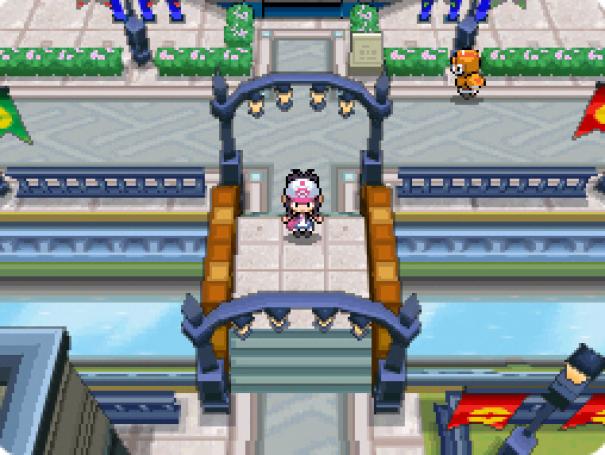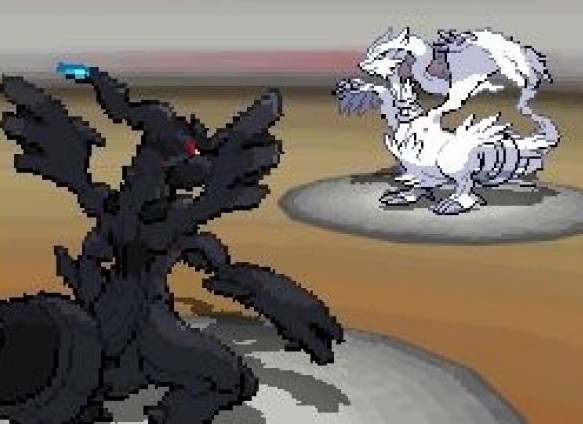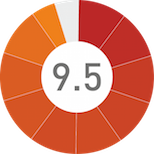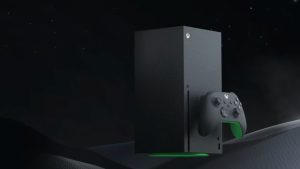Let’s get this out of the way, here and now- Pokemon Black and White are the best handheld games ever created. No other game has had this compelling craft of deep and addictive gameplay that is equally inviting to newcomers and series veterans alike, no other game has managed to evoke these feelings of wonderment and excitement, and a genuine, legitimate curiosity as to what comes next, no other games have actually had a game world as immersive as these games do since the original Gameboy Pokemon games. In every way possible, Pokemon Black and White represent the pitch perfection of the handheld game philosophy- they’re easy to pick up and get into, and can be played in as short or long play sessions as you would want, they represent a genuinely compelling personal story that you instantly connect to, and they actually use all the tech available at their disposal and use it in exciting new ways. Simply put, these are the ultimate handheld titles, and if they are any indication of where Nintendo plans to go next with its handheld software development, then the Big N should really not feel threatened at all by the cheap dollar apps available on smartphones. As long as games like Pokemon Black and White exist, core handheld gaming is going nowhere.
Let’s backtrack, and start at the beginning, though, for those of you who may not have any idea what Pokemon really is, or for those of you who only know it as a billion dollar, media spanning enterprise that is the biggest franchise in gaming today. Look beyond the anime, and the yearly movies, and the trading cards, and the plush merchandise, and what you are left with is a series of exceptionally strong role playing games, that has always been the premier software line on handhelds. The Pokemon games, at their core, are basic JRPGs, and they reflect a lot of the conventions of that genre in their design, replete with countless random battles, turn based battling, experience based leveling up, exploration of secret dungeons for loot and secret characters, and more. To any layperson who takes a casual glance at the series, that is what the Pokemon games will appear to be- heavily simplified JRPGs, made to appeal to the broadest possible demographic.
What a casual glance cannot tell you is that Pokemon are also strategy games, perhaps some of the finest around. There are six hundred and forty nine different Pokemon species available for capture, and each of these can be recruited to be a part of your party. Each Pokemon species can be affiliated to up to two Pokemon elemental types, which range from the obvious (such as Fire, Grass, Water, Electric) to the somewhat more ambiguous (Fighting, Dark, Psychic). Each elemental type is strong against some other types, and weak to others. A Pokemon’s type (or type combination, in case it has more than one type) determines what Pokemon it will be strong against in battle.
Each Pokemon can also learn up to four moves. Moves themselves are also affiliated to one of the seventeen types, and if a Pokemon uses a move that is of the same type as itself (that is, if a, say, fire Pokemon uses a fire move), then it gets an attack bonus. Moreover, moves are also classified into Physical (involves the attacking Pokemon making direct physical attack with the opposing Pokemon), Special (involves the attacking Pokemon damaging the opposing Pokemon without any physical attack) and Status (involves the attacking Pokemon causing some kind of stat change). The effect of each move on the attacking and opposing Pokemon is governed by the six stats that all Pokemon have- Attack, Defense, HP, Special Attack, Special Defense, and Speed.
Head spinning already? That isn’t even half the story told. There are infinite other things that add more complexity to battles, such as equippable items, weather effects, Pokemon abilities, and more. Pokemon battles are incredibly complex, and require thorough training and foresight and planning to be mastered properly. The best part, though, is that the game eases the player into each of these concepts so gradually that by the end, the player will have mastered all of them, but won’t have realized the immense complexity of it all.
The question, of course, is, why do the games focus on Pokemon battling at all? Well, the series focuses on children living in the Pokemon world, on a quest to not only catch all the monsters, but also to train them in Pokemon battles (which are what I suppose can only be termed as an acceptable form of cockfighting), to participate in the world Pokemon championships and become the champion. To do so, the trainer- that is, the kid who’s catching and training Pokemon- must challenge eight different Pokemon League certified gyms throughout the land, to be qualified to participate in the tournament. Most of the times, along the way, the kid has repeated encounters with the local terrorist group that seeks to use Pokemon to further their own nefarious ends.
The reason that I have spent so much time in establishing and explaining the template of the Pokemon games is because it is largely the same in every game of the series, including Pokemon Black and White. To the newcomer, then, the above paragraphs should serve as a basic Pokemon 101 guide, although they are by no means comprehensive. What with the series adding new features and elements to the game incrementally with every major release, the formula of the Pokemon games has grown, been refined and perfected over the years, until last year’s Pokemon HeartGold and SoulSilver, which represented perhaps the ultimate refinement of every single feature that the Pokemon series has had over the years. The problem is, it has also grown somewhat too bloated and stagnant, and the series was in major need of some fresh air. Pokemon Black and White, with their back to the basics approach, don’t exactly reinvent the wheel, but they do give the series just the adrenaline shot it needed.
For starters, let’s be clear on one thing- structurally, the games are still the same as the previous entries in the franchise. If you were really hoping to play as a member of the evil organization, or be a gym leader or a Pokemon breeder, then you’re in for some disappointment. Pokemon as a series thrives on refining and perfecting the same formula, making it feel just new enough each time to warrant a purchase and yet keeping it comfortingly familiar. With Black and White, things have been mixed up, but just enough to make these titles feel refreshingly new. Part of this comes from the fact that the game features all new monsters, and none of the older ones. This forces Pokemon veterans to actually play with the new menagerie of creatures, as opposed to instantly going after old favorites, which, in turn means that they are forced to learn about these new monsters. It’s an exciting thing, trying to figure out what type the Pokemon you’ve just encountered is, trying to figure out which of your moves will work best against it, and it evokes the same kind of feelings that players must have had when they were playing Pokemon Red and Blue.
What also adds to the games feeling fresh is the new region, which is without doubt, the best region to have appeared in a Pokemon game till date. And I mean that in more ways than one. From a geographical perspective, Unova is diverse, with lush forests, sprawling cities, rural settlements tucked away in some unsuspecting corner, and sprawling bridges. From a gameplay perspective, this probably represents the best world design that Game Freak have ever come up with, with the world having tons of secrets meticulously tucked away, and posing significant challenges to the player at every turn, without the need for the game breaking Hidden Moves that were required to progress in the earlier games.
Yep, you heard that right. Whereas this game still has HMs- seven of them, in fact- none of them are needed to progress in the game (except for Cut, which needs to be used once very early in the game). The only thing you’ll need them for is to access secret legendary Pokemon and hidden areas and dungeons. This means that you can finally concentrate on both, your progress through the game, and bringing up a well rounded team without having to worry about having an HM decoy Pokemon that drags your team down. This, along with the fact that TMs are now infinite use, leading to customizable move sets that fans have always wanted, do wonders for the game.
The makers of the game however, evidently realized that the star of the show is not the main character, or any of the surprisingly well developed supporting characters (more on that in a minute) this time around, but rather, it’s Unova. I say this this because they clearly went to excessive lengths to present Unova to the player in a way that leaves a lasting impression. With dynamic camera angles, close ins and zoom outs, 3D cutscenes and panorama sweeping camera pans, Unova is sure to leave an impression on your mind.
The changes in the graphics aren’t just limited to the overworld alone, however. After more than a decade of being stuck with Gameboy era slide show battles, Pokemon battles have finally been given a makeover, and while it isn’t what we would have liked, it still makes for a nice change from the static affairs that we’ve been stuck with so far. In battles, your Pokemon are constantly moving around, wagging their tails, ears twitching, legs bounding, and they in fact even respond to status changes- a sleeping Pokemon, for instance, will have its eyes closed. The camera now zooms in and out at dramatic moments, giving the player a better feel of the battle, and this, accompanied with the new improved attack animations, makes battles actually look impressive for a change.
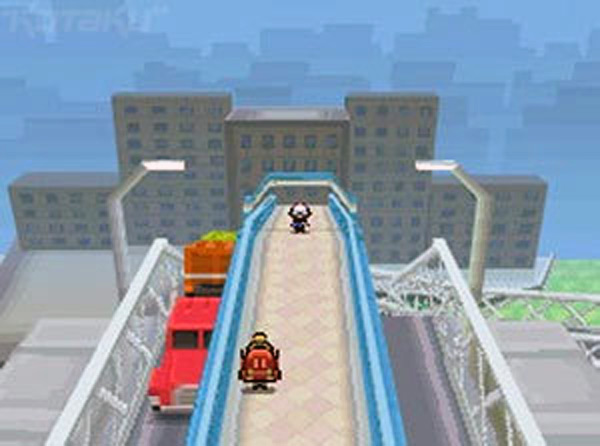
Bridge porn! No, seriously, there’s like a dozen different brdges in this game, all shown off in painstaking detail.
However, all of these new aesthetic changes do not bog the speed of the battles down. Players of Pokemon Diamond and Pearl probably remember how frustratingly slow battles were in those games, often dragging out for thirty, forty minutes at a stretch. In Black and White, the entire process has been streamlined with some long overdue changes. So, for instance, you no longer have an animation for the arena weather effect at the end of every turn anymore, but the effect is represented by a small icon on the touch screen. Every time you attack, the opposing Pokemon’s HP meter does not slowly go down to zero like in the previous games, but flashes down instantly to the new HP level instantly. Animations in general have been sped up. This causes the battles to feel reinvigoratingly fast, and represents the game’s design philosophy at large- that of streamlining the overly bloated mechanics to a manageable whole.
This isn’t just limited to battles- for instance, some of the peripheral gameplay mechanics, like berry growing and egg breeding, now take a back seat and are more or less absent from the game until after the main quest has been beaten (which takes a harrowing forty hours). The multi pocketed bag of previous Pokemon games is gone, and we are now left with four pockets- items, medicine, TMs and Key Items. The PC box count is down to eight, and entire menus can now be assigned to the Y button, for ease of access and use.
However, while the game at large has been streamlined well- and by streamlined, I don’t mean dumbed down, as the term has come to mean these days- the menus and interface of this game have taken a baffling step backwards. Players of last year’s HeartGold and SoulSilver will remember that Game Freak more or less perfected the menu and interface design with those games. The menu was always accessible on the touch screen, so you didn’t have to waste time pulling it up by pressing a button, for instance, and more than one item could be hotkeyed, including one to the touch screen, in addition to always on Running Shoes. Well, all of that is gone now. The menu has to be brought up by pressing X (though it can still be controlled with the touch screen once you’ve done that), and you always need to press the B button if you want to run. And while several items, and entire menus, can be assigned to the Y button, you still need to pull up a menu, scroll and select an item or menu. This feels like a step backwards, and also makes you question why the other unused buttons- L and R for instance- weren’t used for anything at all.
But where the interface feels like a step backwards, the game definitely makes leaps and bounds forwards with its story. As all players can attest to, Pokemon has never been about the story, with the plots for the game being laughable at best, and that has changed to a certain degree this time around. This is apparent from the very beginning, as the game adopts a more character and plot driven approach from the get go. The story is now involved with Team Plasma, a group of activists who want all trainers to free their Pokemon, as they believe that humans enslaving Pokemon for their own good is morally wrong. They raise interesting ethical questions and issues, and the game deals with them lightly enough, to make you feel uncomfortable and to put the entire premise of the series into question. How the question is resolved is something I will not reveal, but suffice it to say that what they say is often disturbing, and that feeling never quite goes away.
Better than the story are the characters, from your two best friends, the victory obsessed Cheren, to the bubbly Bianca, who runs away from home to become a Pokemon trainer against her father’s wishes. However, the best and most enigmatic of them all is the mysterious individual known as N, whose motives remain unclear even after he declares his true allegiances, and Ghetsis, the smooth talking man who has something more to him than meets the eye, something sinister.
Of course, with this newfound focus on the story and characters comes a new focus on the presentation of the game. As already explained, graphically, the game leaves no stone unturned, and is perhaps amongst the best looking DS titles till date, which is fitting considering that it is also the last major release planned for the system. However, it is in the sound department that this game truly shines. The music in Pokemon Black and White, from the surprisingly innocent rival battle theme to the rocking remix of the gym music, to the techno jazz Team Plasma battle theme to the nostalgia inducing Elite Four battle theme to the effervescent themes assigned to each of the cities and routes, is undoubtedly the best in the series so far. And whereas I know that most people simply turn the volume down when they’re playing on their handhelds, please, do yourself a favor and get yourself headphones. The music in these games deserves it.
Also what is good is the fact that the ambient sound effects, first introduced in last year’s HeartGold and SoulSilver, are back, although they are much more subtle, and they blend in with the environment more. What is even better is that the Pokemon cries now finally sound like the cries that animals would make, rather than sounding like some weird, distorted, mutated, twisted eight bit cry of torment. This is true, at least, for all of the new Pokemon- bringing in the older Pokemon into the game (which you can do once you’re through with the story mode) means that the older Pokemon will still sound jarringly ancient and perplexingly annoying.
Speaking of the new Pokemon, the new designs definitely take some getting used to, but they are, by and large, very good. The legendary Pokemon look BA as always, but it’s the regular Pokemon where the game simultaneously demonstrates its shining creativity and its flat out laziness. From imaginative designs like Sawk and Timburr and Snivy and Emboar to the flat out stupid ones like Vanillite (an ice cream cone. No, seriously), Klink (Two gears. What. The. Duck.) and Trubbish (a bag of trash. No, I mean it) , this bunch has them all. While these monsters still don’t top the original 251 Pokemon, they’re better than most of the crap that Generation Four threw our way, and that’s a bit of a relief.
Thankfully, you can import your older Pokemon from the DS Pokemon games into these ones once you beat this game’s long story mode, which clocks in at more than forty hours. This excessively long play time means that this game gives you more bang for your buck than almost any other console title released these days. But there’s more! In addition to the full featured single player mode, Pokemon Black and White have the most full featured online and local multiplayer mode for any Nintendo game, Pokemon or otherwise, till date. There’s finally random battling online, and the GTS returns in a much improved form, allowing for negotiated trades. The bulk of the online options are still accessed via Friend Codes, which is a shame, but the local multiplayer shines thanks to the new IR support that is native to these games, which allows for much faster local battling and trading without having to go to a Pokemon Center (yes, I know!). All of this ensures that Black and White will be firmly lodged in your DS game slot for years and years to come.
It basically boils down to this- Pokemon Black and White are the best handheld games ever. They are also quite obviously the best Pokemon games ever, better than even Gold and Silver, and the most full featured yet accessible titles in the series to date. Where Pokemon will go next is anybody’s guess, especially seeing how the developers seem to be running out of ideas for new creatures, and how the 3DS will afford them with all the power of a home console, but that doesn’t matter- Black and White remind you why you would care in the first place, they remind you why handheld gaming is still relevant. Surprisingly poignant and touching, epic and grand in scale, fun and familiar, new and old, Pokemon Black and White is a game that any and every self respecting gamer should go out and buy immediately.
This game was reviewed on the Nintendo DS.
Exceptionally strong plotline and character development; new Pokemon designs are by and large good; streamlined to its core essence, making this the best Pokemon title to play through; new battle modes add a new element of strategy; Unova is the best region seen in a Pokemon game so far; gorgeous graphics; new local and online connectivity modes are top of the line; excellent music; addictive gameplay; changes the Pokemon formula up consideably
Some new Pokemon designs just look weird, uninspired or flat out lazy; the interface isn't as intuitive or streamlined as it was in HeartGold/SoulSilver









